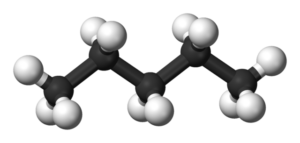Playlist
Show Playlist
Hide Playlist
Stability of Carbocations – Alkanes and Alkenes
-
Slides Alkanes and Alkenes.pdf
-
Download Lecture Overview
00:01 However, which one is the more likely? And I bring you back to hybridisation from Module I and the stability of carbocations. So, the reason why you get one over the other is by virtue of the stability imparted by electron donating groups. This is our so called positive inductive effect, if you go back to the previous module. 00:24 If we look at what’s happening in the first instance, when the double bond is split, when the two electrons are transferred on to H+ and form a sigma bond between the carbon and the hydrogen, we are left with an empty p orbital. It was originally hybridised, but now, it is not. It is a p orbital that has that dumbbell shape, as we saw before. Also as a consequence, as you can hopefully appreciate, it is technically now sp2 hybridised. As a direct consequence, it adopts a trigonal planar structure. 00:54 And whilst this may not necessarily seem important at the moment, from a stereochemical perspective, it will become important later on. But, more importantly, it has a formal positive charge on it. And as you can see, if we look at different degrees of substitution on that single carbon, we can see degrees of stability imparted. Tertiary - what that means is we have three alkyl groups attached to that positively charged carbon. Secondary - so we have two alkyl groups attached to that secondary… that… that positively charged carbon or primary - where we have only one alkyl group attached and then finally, methyl - where we only actually have hydrogens on the carbon which is positively charged. 01:39 Alkyl groups, by their nature, are electron donating. And therefore, the carbocation can be stabilised by more electron donating alkyl groups and that’s what we see in the case of the tertiary, okay, the three, and again, with that little sort of degree sign above it, tertiary. Alkyl groups are electron donating and by virtue of their inductive effect, can stabilise better that carbocation. What that means in the context of our reaction is that the addition of H+ on to our double bond which results in a carbocation being present in the central carbon on our propene molecule is actually the preferred intermediate resulting in the two bromopropane being the only product that results. So, in this scenario, the electrophilic addition of any unsymmetrical reagent to an unsymmetrical double bond proceeds in such a way as to involve the most stable carbocation. As you can see the carbocation afforded when the reaction takes place at C-2, is actually less stable because it is primary as opposed to secondary. 02:49 The H+ will also add to the carbon that already has more hydrogens.
About the Lecture
The lecture Stability of Carbocations – Alkanes and Alkenes by Adam Le Gresley, PhD is from the course Organic Chemistry.
Included Quiz Questions
The order of stability of carbocations is which of the following?
- Tertiary > Secondary > Primary > Methyl
- Tertiary > Methyl > Secondary > Primary
- Primary > Secondary > Tertiary > Methyl
- Methyl > Tertiary > Secondary > Primary
- Methyl > Primary > Secondary > Tertiary
The tertiary carbocation is highly stable due to…?
- Electron-releasing effect of the alkyl group
- Electron-withdrawing effect of the alkyl group
- Electron-releasing effect of H
- Electron-withdrawing effect of H
- Electron-withdrawing effect of halogens
Customer reviews
5,0 of 5 stars
| 5 Stars |
|
5 |
| 4 Stars |
|
0 |
| 3 Stars |
|
0 |
| 2 Stars |
|
0 |
| 1 Star |
|
0 |




